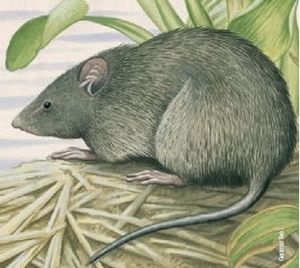Fossorial giant rat facts for kids
Quick facts for kids Fossorial giant rat |
|
|---|---|
 |
|
| Illustration | |
| Conservation status | |
| Scientific classification | |
| Genus: |
Gyldenstolpia
|
| Species: |
fronto
|
| Synonyms | |
|
|
The fossorial giant rat (Gyldenstolpia fronto) is a type of rodent that belongs to the Cricetidae family. It was once found in Argentina and Brazil. Sadly, experts now believe it is extinct, meaning it has completely disappeared from Earth.
This rat was called "fossorial" because it was good at digging. Its natural home was probably dry savanna areas, which are like grasslands with scattered trees. However, not much is known about its daily life or habits.
Contents
About the Fossorial Giant Rat
The fossorial giant rat is a fascinating creature, even though it is no longer with us. It was a unique rodent with special features that helped it live underground.
What is a Fossorial Rat?
The word "fossorial" means an animal that is adapted for digging and living underground. The fossorial giant rat had a body shape that made it good at burrowing. This helped it find food and stay safe from predators.
How Scientists Group Animals
Scientists use a system called taxonomy to group living things. This helps them understand how different species are related to each other.
The Gyldenstolpia Family Tree
The fossorial giant rat, known scientifically as Gyldenstolpia fronto, is one of two species in its group, called a genus. This genus is named Gyldenstolpia. The other species is G. planaltensis, which is smaller.
In 2009, scientists recognized two types of Gyldenstolpia fronto: G. fronto chacoensis and G. fronto fronto. These are called subspecies, which are like different populations within the same species.
Changing Names: From Kunsia to Gyldenstolpia
For a while, the fossorial giant rat was thought to be part of a different genus called Kunsia. But after more study, scientists realized it belonged in the Gyldenstolpia genus. This group of rodents, called Sigmodontine rodents, is known from only a few fossils and some recent animals found in central South America.
The two species in the Gyldenstolpia genus, G. fronto and G. planaltensis, are quite large compared to other rodents in their wider group. Gyldenstolpia fronto was the bigger of the two.
What the Fossorial Giant Rat Looked Like
The way an animal is built is called its morphology. The Gyldenstolpia rats had some special features.
Key Features of G. fronto
Gyldenstolpia fronto looked similar to other rodents like Scapteromys and Kunsia. Here are some of its defining features:
- Strong Skull: It had a strong skull with a narrow area between its eyes.
- Small Ears: Its ears were rounded and somewhat hidden, which is common for digging animals.
- Thick Fur: Its back was covered in thick, bristly hair.
- Tiny Eyes: It had small eyes, which makes sense for an animal that spends a lot of time underground.
- Short Tail: Its tail was short compared to the rest of its body.
See also
 In Spanish: Gyldenstolpia fronto para niños
In Spanish: Gyldenstolpia fronto para niños


